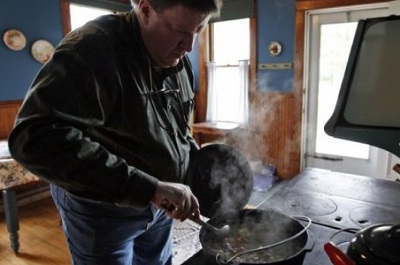Survivalist’ Leads Classes on How to use a Woodstove
TOWN OF WESTPORT — The thought of preparing food on a wood-burning stove in a kitchen that looks like it was plucked from a 1920s still-life painting might seem idyllic. But the reality of making dinner without running water, a microwave or all the other appliances in modern kitchens is something else.
A chance to try cooking circa 1920 is coming up on Nov. 20 at Schumacher Farm Park, a 40-acre historic farmstead on the eastern edge of Waunakee. Steve Keip, a member of the farm's Friends group, will lead a class on the finer points of using a wood-burning stove.
Participants will do all the work themselves, from peeling root vegetables to putting on the coffee. Then everyone will sit down to dinner straight from the 1920s and '30s, including chicken fricassee with root vegetables, green onion pie and pineapple upside-down cake.
 Keip has plenty of experience using a wood-burning stove. He took a class at Old World Wisconsin and mans the Schumacher Farm stove for fundraising events, including occasional cooking classes. He even has a wood stove at his home, which can be used for both heating and cooking.
Keip has plenty of experience using a wood-burning stove. He took a class at Old World Wisconsin and mans the Schumacher Farm stove for fundraising events, including occasional cooking classes. He even has a wood stove at his home, which can be used for both heating and cooking.
"I am sort of a survivalist," Keip said. "I like to know that the power can go out and I'll still be able to take care of my family. That's what they had to do out here in the 1920s."
Keip's day job is catering director for Edgewater Hotel, where efficiency is paramount. Using a wood-burning stove is cooking the hard way.
"It took me 40 minutes to get the stove to 400 degrees," he said on a recent afternoon as he stirred a pork stew with root vegetables. Biscuits along with homemade relishes, preserves and pickles — all made on the wood-burning stove — waited on an old harvest table across the kitchen.
"There's a steep learning curve for wood-burning stoves," Keip said. His first attempt to bake bread resulted in charcoal.
Eventually, Keip learned how to control the stove's temperature with wood fed into the firebox on the left side. Cooking also involves an elaborate dance of moving cast-iron pots and pans around the stovetop to find a spot offering the right amount of heat at any particular moment. At the back of the stove is a screen that is moved back and forth to encourage heat to move one way or the other.
The porcelain enamel stove at Schumacher Farm, a replacement for the farm's original, was made in the 1920s by the Rock Island Stove Co., in Illinois.
"The original stove had long been removed as the house was modernized over the years," said site director Diane Schwartz. The chimney above the roof had to be rebuilt and a copper shield installed behind the stove to meet modern building standards, she added.